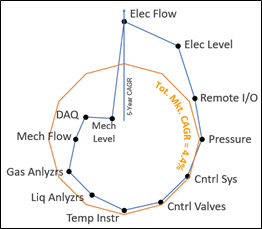Process Instrumentation and Automation Market to Grow at 4.4%
The process instrumentation and automation market in the United States, currently valued at $13.9 billion, is projected to grow at a compounded annual growth rate (CAGR) of 4.4% and reach a total of $17.3 billion in 2023, according to a market forecast published by the Measurement, Control & Automation Association (MCAA). The percentage increase over the five years is projected to be about 24%. The reported market value slightly exceeded the $13.6 billion projected for 2018 in the 2014 MCAA Market report.
#VMAnews #automation
The MCAA annual forecast report, prepared by the analysts at Global Automation Research LLC, focuses on the process instrumentation and automation (PI&A) markets in the United States and Canada. It examines 12 industry segments and 12 product categories.
PRODUCT CATEGORY PROJECTED GROWTH
Of the product types considered (listed below), process control systems and process control valves represent 60% of the market total for 2018, according to the report.
- control systems
- control valves
- data acquisition devices
- flowmeters, electronic
- flowmeters, mechanical
- gas analyzers
- level sensors, electronic
- level sensors, mechanical
- liquid analyzers
- pressure sensors
- remote I/O
- temperature instrumentation
Figure 1 shows the growth rate of the 12 product categories, relative to the 4.4% overall 5-year projected growth rate of the market.
The fastest growing product categories are electronic flow, electronic level and remote I/O. The report shows that the displacement of some older technologies (e.g., mechanical flowmeters, mechanical level meters and data acquisition instruments) continue as the process industry adopts electronic flow and level meters and implements expanded DCS, PLC and SCADA capabilities.
U.S. MARKET SECTORS FORECAST
Three industries—chemicals, oil refining and electric utilities—accounted for more than 50% of the total process automation market in 2018 (Figure 2). These three industries, plus food & beverage and pharmaceuticals will be the fastest growing segments over the 5-year forecast period, the report stated.
“There are strong growth drivers in each of these industries,” said Paul Rasmusson, president, Global Automation Research LLC, “including the build-out in ethylene plants, capacity expansions in oil refineries, new natural gas-fired generators, and the growing drive for automation to improve productivity, enhance quality and safety, and extend plant life in the pharmaceutical and food & beverage sectors.”
The report shows that oil and gas process automation spending recovered strongly in 2018, with most of the growth in the midstream segment. Also, spending in the U.S. steel industry shows growth in response to tariff-related domestic demand.
“A slowing global economy could reduce demand for plastics,” Rasmusson said, “creating an excess in ethylene production and oil refining capacity causing delayed or cancelled projects. A U.S. recession would reduce demand for process industry products across the board, undermining the forecast growth in process automation spending.”
CANADIAN PROCESS AUTOMATION MARKET FORECAST
The report shows the Canadian process automation market valued at $1.3 billion and forecast to grow to $1.5 billion by 2023, a five-year CAGR of 3.4%. Five industries—food and beverage, chemicals, pharmaceuticals, oil refining and electric utilities—will grow above average. Two major industry sectors are struggling, the report said. Oil and gas sector growth is limited due to production constraints in Alberta. However, these constraints may ease with revised curtailment rules, as reported by the CBC. Spending in the Canadian metals industry dropped after imposition of the Trump tariffs though recent indications the tariffs will be dropped offer hope that some spending could be restored in the metals sector.
Barbara Donohue is web editor for VALVEmagazine.com.
RELATED CONTENT
-
ValvTechnologies and Severn Form Strategic Partnership
ValvTechnologies and Severn Glocon have reached a partnership agreement that will see collaboration between two of the world’s leading engineering and manufacturing companies specializing in innovative, high-end, severe-service valves.
-
New Requirements for Actuator Sizing
After decades of confusion, the American Water Works Association has created new standards for actuator sizing that clear up some of the confusion and also provide guidance on where safety factors need to be applied.
-
Virtual Valve Forum and Basics Event Draws Attendees from Across the Industry
More than 200 people from across the valve industry participated virtually in the VMA Valve Forum and Valve Basics event, which included 4 days of presentations on technical, manufacturing, management and marketing, valves 101, and valve repair.











 Unloading large gate valve.jpg;maxWidth=214)